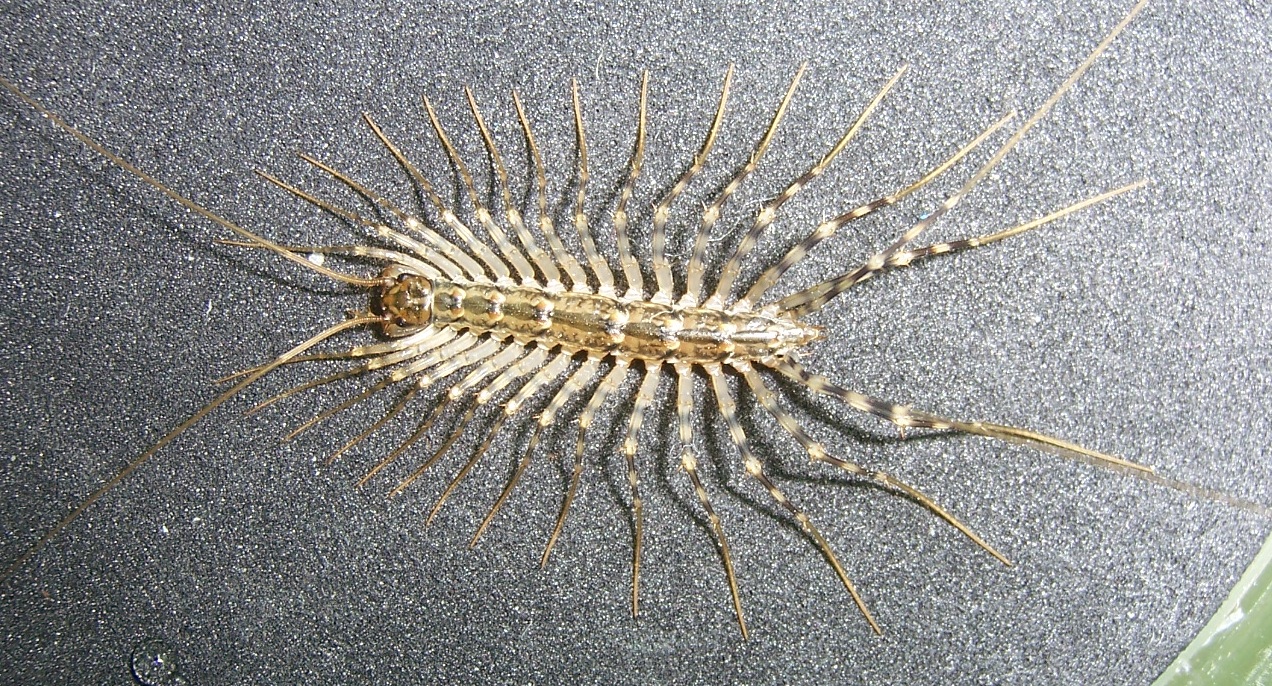
How many joints?
image source

Will it walk?

How many joints?
image source

Will it walk?
As stated elsewhere in this manual, robots move. To accomplish this, most have at least a few moving mechanical parts. Some have many. The contrivances that allow parts of a robot to move with respect to each other while maintaining physical connectedness are broadly referred to as joints. In this sense, the term covers a variety of mechanisms, from wheels and axles, to telescoping tubes, to ball-and-socket articulation, to complex cammed devices.
All joints, in addition to allowing movement, also constrain it. A joint can be described either in terms of the movement it allows, or in terms of the movement it prohibits. This is a crucially important observation. The two descriptions are flip sides of the same reality, but one is often easier to think about than the other. An axle permits rotation about a single fixed axis. A rod mounted on a ball and socket prevents the rod endpoint from leaving the surface of a sphere.
Joints can be classified in terms of the constraints they place on the relative movement of the parts they connect. Two unconstrained rigid bodies can move in six degrees of freedom with respect to each other. We often break this into three translational freedoms and three rotational freedoms. This approach corresponds to conventions people employ (possibly intuitively) when describing movement of objects, though it is not the only compact way of describing the situation mathematically. Even translation/rotation is not simple. There are several equally "natural" ways of describing rotation, as anyone who has attempted to do so quantitatively has discovered (usually to their great confusion), and the primitives combine in non-intuitive, non-reversible (technically non-commutative) ways.
Fortunately, many common joints allow simpler analysis because they constrain motion to a single dimension of this six-dimensional space (technically a one-dimensional locus). There is standard terminology for the simple one-dimensional movements: A revolute or rotational joint allows only rotation about a single fixed axis. Basically a hinge or an axle. A prismatic joint allows only translation along a fixed line, with no relative rotation. Basically a slide or track. It is common in robot design to construct complex joints by combining simple rotational and prismatic elements. This both allows standard parts to be used, and permits standard, well-developed methods of mathematical analysis to be employed.
The study of how forces propagate through stationary elements, including
set joints, is called
statics.
The study of how position and velocity propagates through robot joints
and the elements they connect is called
robot kinematics.
The study of how accelerations and inertial forces
propagate through joint-connected moving elements is called
robot dynamics.
Compared to point-Newtonian mechanics, the problems are complicated.
Some sophisticated mathematical tools have been developed to aid the
analysis of multi-joint systems, most relying heavily on the methods
of linear algebra.
If you are at the U of R and want to learn the gory details,
take Tom Howard's CSC/ECE 231 course in robotics.
A rotational joint allows two 3-dimensional bodies to rotate relative to each other about a fixed axis and permits no other relative motion. It is, by far, the most common joint in robotic and other mechanical systems, and more complex linkages are often constructed by composing simple rotational joints. In many designs there is a physical shaft called an axle, or in hinges a pin, corresponding to the rotational axis. The possible variation in relative position is completely described by a single angular parameter, which can be measured from any convenient reference point.
Depending on the situation, the count of full (360-degree) rotations from zero (sometimes called the winding number) may or may not be relevant. For example, if the joint supports a wheel in contact with the ground, then you need to know the winding number to determine how far that wheel has rolled. The joint between a motor stator and rotor may be linked to another joint through a gear-down transmission, in which case the rotation count is needed to determine the position of the second joint. On the other hand, if the joint is the knee of a robot leg that moves only in a 180-degree range, then the rotation count is irrelevant.
There is well-developed technology implementing rotational joints. They can be made strong, compact, and well protected from the environment. A simple axle joint can be made by drilling a hole through one object, and sticking a rod or shaft attached to the other object through the hole. If the fit is loose enough to allow rotation, and sliding movement along the shaft is prevented with a pin, nut, or other retainer, the configuration forms a simple rotational joint.
The simple rod-in-hole design has a number of serious problems. First, in order for rotation to take place, the material of one object must slide with respect to the other around the axle shaft. The portions of any joint that move in contact with each other and transmit a load are called bearing surfaces. Friction between bearing surfaces can inhibit free motion, and rubbing can cause rapid wear of the components. This problem can be ameliorated by lubricating the shaft with grease, by using materials that slide freely with respect to each other, or by ball or roller bearing designs. These are discussed in more detail in the next section
Another source of problems is looseness between the shaft and the rotating object. Any significant tilt of a simple hole relative to the shaft causes the contact area to be reduced small regions at the edges of the hole, creating pressures that can be large enough to deform and damage the components. Grooving of the axle can occur.
More surprisingly, even small amounts of play or flexibility in a rotating system can allow dynamic instability or self-oscillation to develop, especially as speed increases. For example, a free disk spinning on a shaft with a loose fit, or a wheel in contact with the ground through a flexible tire, can start to wobble violently on the axle. The phenomenon is sometimes referred to as shimmy, and can cause loss of control, rapid wear, and catastrophic failure of the joint. Dynamic instability issues can be reduced by using a hole whose length is several (5-10) times its diameter, or by supporting an axle at two (or more) different points. Using precisely machined bearings to limit tilt or wobble also helps. Commercial bearings often have clearances of less than a thousandth of an inch (.025mm).
In system design, an obvious principle is to avoid resonances that are close to rotational frequencies. In practice, this usually involves making frameworks as stiff as practical everywhere that flexibility is not required, and then strongly damping any modes that remain problematic. This does not prevent all dynamic instabilities, as not all arise directly from elastic vibrational modes, but it certainly helps.
In general, any design element that reduces or strongly damps
the ability of a rotating element to wobble or to move in ways other
than pure rotation will reduce the chances of dynamic instability.
This is not always possible. Systems that permit a wheeled
vehicle to be steered often require that wheels be allowed to move
out of a single plane of rotation.
Unsurprisingly, steering systems are prone to dynamic instabilities.
Early automobiles suffered from problems with violent steering shimmy
that could develop suddenly at high speed and cause total loss of vehicle
control.
It took decades of semi-empirical design fiddling to fix the problem.
A dynamic instability involving steel railroad wheels on steel track
limited railroad speeds to about 150 mph until the 1990s, when
computer-assisted analysis permitted design changes to be found
that allowed speeds of up to 300 mph.
(Above that, they still tear themselves apart, which accounts for
the interest in mag-lev technology).
A prismatic joint is one that allows translation along a line. A simple prismatic joint can be made using the same rod-in-hole design discussed above under rotary joint. But instead of restraining the block from sliding and allowing it to rotate, we prevent it from rotating and allow it to slide. The hole is usually longer than it is wide to prevent frictional tilt latching that can occur if a transverse torque is applied to the block (one that would tilt the hole out of line with the rod). An exception is sometimes found in pistons (a form of prismatic joint) where compactness is important. They are prevented from tilt locking by careful engineering. Interestingly, the latching phenomenon is deliberately employed to make adjustable locking mechanisms consisting of a rod passing loosely through a hole in one or more tiltable plates that are significantly thinner than its diameter.
A common design for plain prismatic joints is to pass two parallel rods through parallel holes in a sliding block. This prevents rotation, and further guards against tilt latching. As with rotary joints, lubrication is critical for good performance. And as with simple rotary joints, the holes are often lined with special materials to decrease friction and reduce wear. Bronze, plastic, and self-lubricating sintered metals are common. Plain prismatic joints tend to have relatively high friction, and usually will not coast far under their own inertia. This is in contrast to wheels using plain bearings, which benefit from a torque-leverage effect about the small-diameter axle, and can coast for many revolutions.
Prismatic joints can be fitted with balls or rollers to
reduce friction. A variety of designs are used.
It is also possible to make fluid-supported prismatic joints, but
they generally need pumped lubricants, which must be collected and
recycled (messy and complicated).
This is in contrast to rotary joints where
the closed circular geometry inside a bearing coupled with
the rotational motion can be employed to continuously cycle
lubricant between bearing surfaces.
A cylindrical joint can be viewed as a rod-in-hole arrangment that
allows both sliding and rotational movement. It has two degrees of
freedom. Cylindrical joints are often used in adjustment mechanisms,
allowing both the position and orientation of a component to be aligned
and then locked down with a single screw or clamp.
Powered cylindrical joints are usually implemented by combining separate
prismatic and rotational mechanisms, which yields a kinematically
equivalent system.
A ball-and-socket joint is what you get if you attach a rod to a ball, and surround the ball with a partial spherical enclosure (the socket). Usually the socket subtends more than a hemisphere so that the ball does not fall out. The size and shape of the remaining opening restrict the movement of the joint. This joint has three degrees of freedom corresponding to the three rotations of a sphere. Physical ball-and-socket joints are sometimes used as adjustment mechanisms, usually in low-stress applications since they are more difficult to clamp securely than cylindrical joints. They also occur in biological systems such as the human hip and shoulder.
Powered systems with ball-and-socket kinematics are usually
implemented through combinations of three rotational joints,
cleverly arranged so that all three rotational axes intersect
at or near the same point.
The kinematics are often not exactly equivalent, and there
are sometimes singularities -- positions where one or more
degrees of freedom are lost due to incidental alignment
of rotational axes.
Usually however, a functionally suitable system can be implemented.
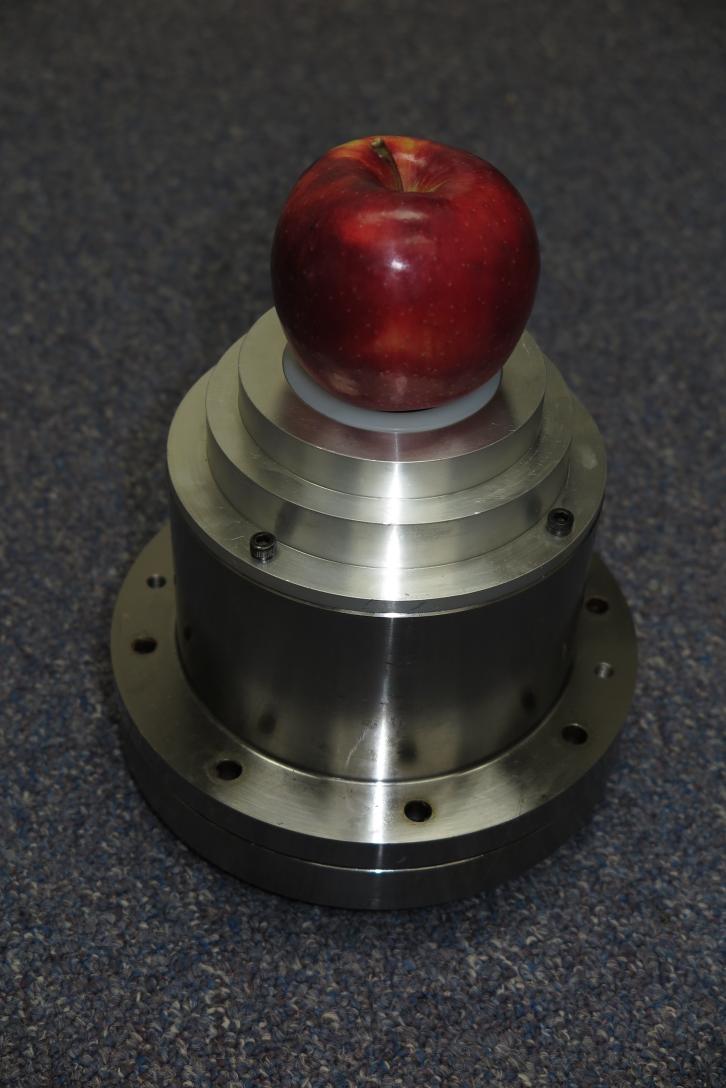
Large double roller bearing
from a Puma 760 robot arm
The mechanical component that permits rotational motion (or in-contact motion of any type) is referred to as a bearing. Plain, ball, and roller bearings are commercially available in a large number of standard sizes. A typical commercial rotary bearing is made to fit around a shaft of specified inner diameter, and to be mounted in a hole or tube of specified outer diameter. The length is also specified. Commercial bearings tend to be relatively short, and a shaft of any length is often supported by a bearing at each end. As a rule of thumb, a loaded shaft should not extend out of a single bearing by more than its own diameter or the length of the bearing, whichever is smaller. The unbalanced torque resulting from poor loading will cause rapid wear and failure for most bearing types.
Bearings are classified according to the direction of the forces they can support. The most common type is designed to support a radial load (perpendicular to the shaft) of the sort that would be encountered on a wheeled vehicle. A bearing must be specially designed to support axial loads (forces acting along the shaft), and often a design can sustain axial forces in only one direction. Such axial-load bearings are sometimes referred to as thrust bearings, and may or may not be capable of also supporting radial loads. Always check the spec. If an axial load is imposed on a bearing intended to support only radial forces, it will often just fall apart. Even if it doesn't, the bearing will experience rapid, destructive wear.
A plain bearing is one where the bearing surfaces make direct contact with each other, as opposed to having intervening balls or rollers (or fluids or magnetic fields). The rod-in-hole design mentioned above is a crude plain bearing. A rotational plain bearing designed to support radial loads is sometimes referred to as a journal bearing, "journal" referring to the hole-containing component.
A number of innovations serve to improve the crude rod-in-hole design. Because like materials rubbing against each other tend to produce rapidly destructive wear, shaft and journal are frequently made of different materials. Usually one is very hard, and the other softer, but wear resistant. Hardened steel shafts in journals made of or lined with bronze, cast-iron, babbit metal, or various plastics are a common combination. Journals often consist of a replaceable sleeve or bushing of bearing material held in a housing. This enhances repairability and can lower material costs in manufacturing.
Lubrication is critical to obtain sufficiently low wear and friction in most plain bearings. Often simple coatings of oil or grease, or a solid lubricant such as graphite suffice. Such bearings may require periodic relubrication. More sophisticated "sealed" bearings may have a journal made of sintered metal or other porous material that is either permanently impregnated with a lubricant, or wicks it from a reservoir.
Other systems actually ride on a thin layer of lubricant that is either pumped through the bearing, or drawn up between the bearing surfaces by the rotating shaft. The bearing materials never touch each other directly, except possibly at startup. These are more properly referred to as fluid bearings, but their design space overlaps lubricated plain bearings, which often effectively operate mostly in a fluid-supported regime. This fluid-layer phenomenon is responsible for much of the effectiveness of standard lubrication procedures, though the fact was not recognized when the properties of lubricants were first discovered (sometime in antiquity).
Because contact between bearing surfaces is over a portion of a cylinder, plain bearings can accomodate high loads. They can also run at very high speeds and can be made very stiff, with minimal play. Their main drawback is relatively high friction, especially at startup, and the possibility of rapid wear particularly if lubrication is compromised. Most cannot be adjusted for wear. If the bearing is functioning as a fluid bearing, then running friction and wear approach zero.
Plain bearings can be designed to function under axial loads, in which case they are a form of thrust bearing. This is usually accomplished via rings or plates attached to the axle and journal that slide with respect to each other Thrust bearings are harder to keep lubricated than journal bearings because the rotating action under pressure tends to squeeze lubricant out from between the plates. This problem is avoided in journal bearings where the motion pulls the lubricant around between the axle and the journal in a circular motion, redistributing it exactly where it is needed. Forced/pumped lubrication can resolve the issue, but increases system complexity. An invention known as a tilting-pad fluid bearing provides a local distribution mechanism.
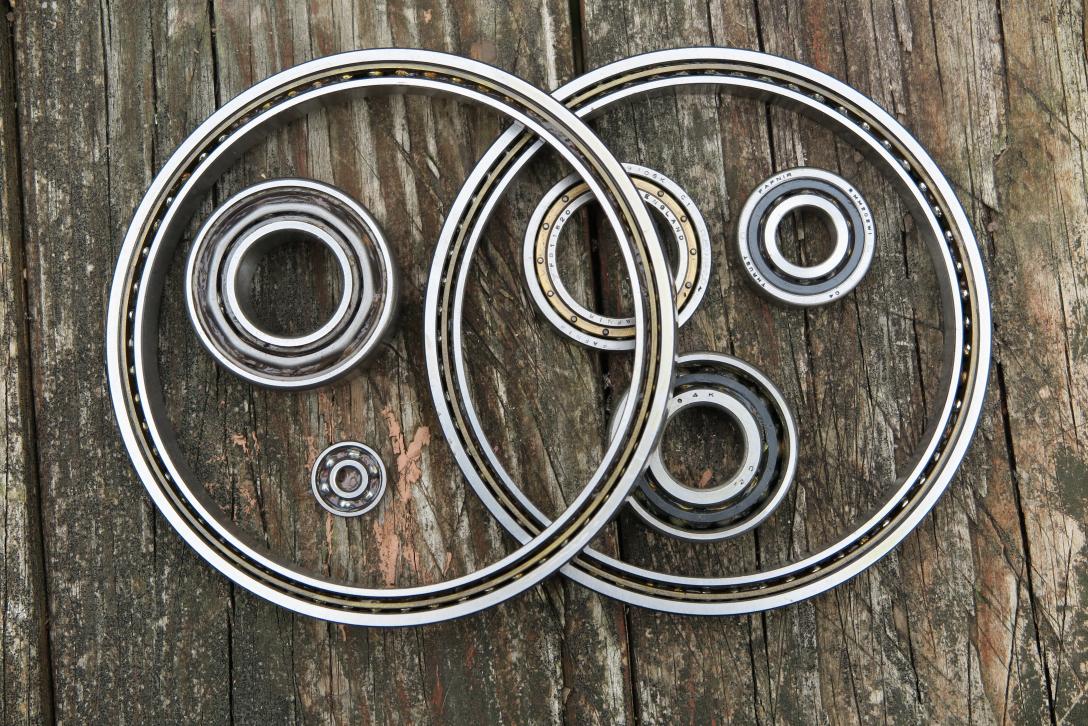
Ball bearings
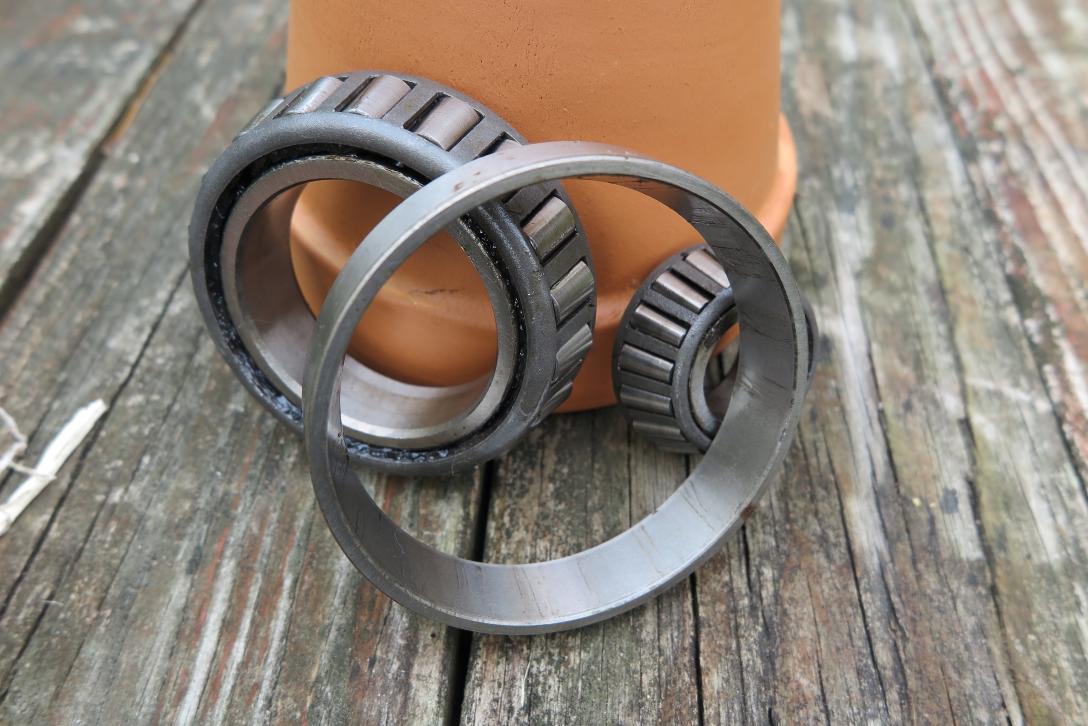
Roller bearings
Friction between surfaces can be greatly reduced by placing rolling elements such as balls or cylinders between them. This is the essential idea in ball and roller bearings.
In a ball bearing a set of spherical balls is introduced between the shaft and the journal. These are confined by inner and outer races, essentially grooved tracks placed around the outside of the axle and the inside of the journal. The races also serve to spread the point contact of a sphere with a surface into a(short) tangent. Spacing between balls is maintained by a loosely fit "cage", which keeps them from rubbing agains each other. The balls and races must be made of hard material, precisely ground. Any irregularities will produce vibration in the bearing. Surfaces in commercial ball bearings are often locally true to a few millionths of an inch (tens of nanometers). Ball bearings still need some lubrication as there is a small amount of essential geometric slippage when a sphere rolls along a typical race.
Ball bearings function well at low to moderate speeds, and under moderate loads. They have almost no tendency to stick at startup, or seize in place. They have running friction significantly lower than journal bearings of comparable size, unless the journals are running in a fluid-supported regime. The space between the balls can store grease or other lubricant, and if this is prevented from escaping out the sides by appropriate seals, they can run a long time without relubrication.
On the down side, since the load is borne by small sections of small spheres, ball bearings do not have the load-carrying potential of journal bearings. They also tend to have more play, and have almost no ability to resist transverse deflection of the axle (forces that would tilt a wheel out of perpendicular). For this reason they are often used in pairs, e.g., one at either end of an axle. When pairs are used, care must be taken that the bearing axes are properly aligned. "Self aligning" types can tolerate a degree or two of misalignment; others must be aligned within a few minutes of arc.
Ball bearings are well adapted to axial-load (thrust) applications. Balls can easily be inserted in tracks between thrust plates where they allow relative movement with little friction and maintain a space that can be filled with lubricant that has no tendency to be squeezed out. If placed in deep races around an axle and journal (assembed somehow) a single set of balls can support both radial and axial loads.
Roller bearings are like ball bearings, except that the rolling element is a cylinder instead of a sphere. This increases the contact area, and hence the radial load-carrying ability of the bearing. It also provides some resistance to transverse deflection. A tapered roller bearing uses tapered rollers fit between conical sections. This design can take high thrust as well as radial loads. Roller bearings are frequently used in automobile wheels and heavy machinery that is frequently stopped and started, especially where pressurized fluid bearings are impractical for one reason or another (e.g. there is no access to pressurized lubricant). A roller bearing with long, thin rollers is sometimes called a "needle bearing".
Wikipedia on rolling element bearings.
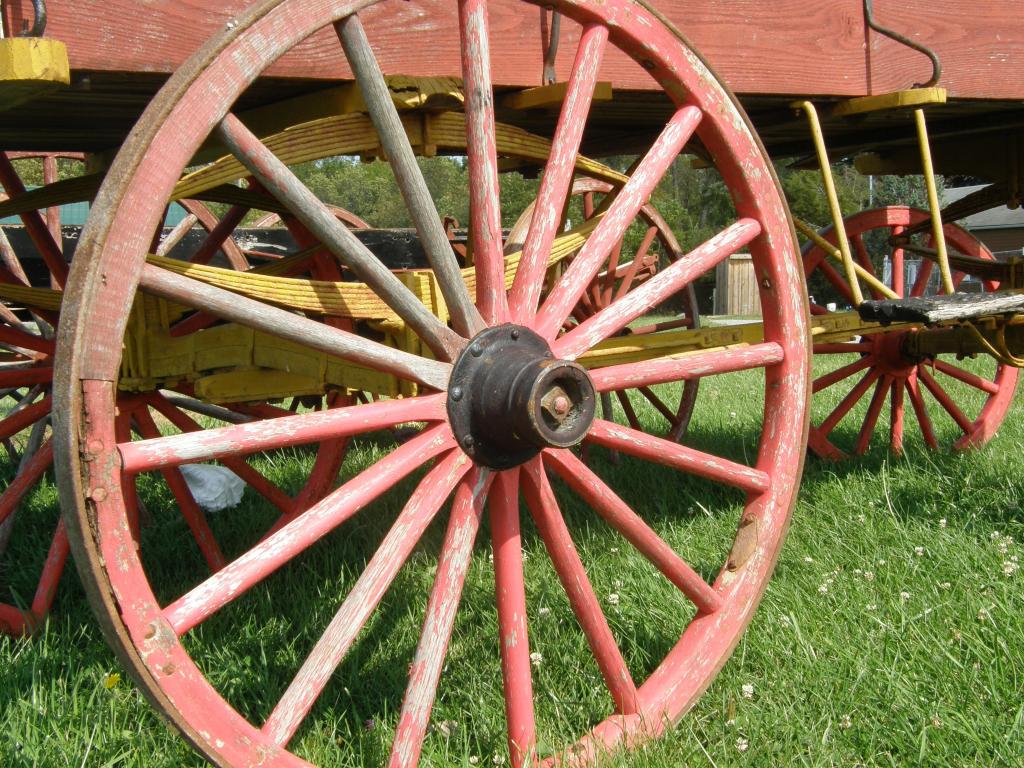
Spoked wooden wheels
Wheels have wheels and wheels within wheels
and lots of 'bots have wheels.
Some say the wheel is man's most significant
mechanical invention. Some say the lever.
Be that as it may, the significance of wheels in antiquity was clear:
they allowed heavy loads to be moved across dry land with a fraction
of the force and energy needed to drag them.
This remarkable ability is due to what can be iterpreted as a
continuous lever effect
arising from the interaction of the wheel with the supporting axle.
A tangential force at the circumference is magnified at the surface of
the axle by the ratio of the wheel radius to the axle radius.
However the downward weight that produces friction is the same.
Thus the wheel slips at the axle rather than along the ground, and with
far less pulling force.
Wheeled vehicles have been made for at least 6000 years, but making an effective wheel has historically been a challenge. A wheel needs to be accurately circular about its center. It needs to strongly resist both compressional forces and lateral sheer, and also the torsion that moves the wheel on its axle. And it helps if it is lightweight. Stone is extremely heavy, difficult to work accurately, and has poor sheer and torsional strength. The cartoon "log slice" wheel is not really practical. It has the weak direction of the wood grain in all the directions it needs to be strong, and tends to split and fail as soon as it is put into use (if not before). A functional wheel can be made by pegging together boards at right angles and cutting a circle - the cartoon medieval wheel - but this design is heavy, and has a rough circumference that has a tendency to split, go out of round, pick up water and dirt, and rot.
The first efficient spoked wheels seem to have appeared in central Asia, about 4000 years ago (nobody is really sure) and spread rapidly. They were highly engineered to use the strength properties of wood effectively. Spokes transfer compressional forces to a hub. The rim, made of curved sections or wood bent into a circle, resists bending and transfers ground forces to the spokes. In concert with the spokes, it provids strong lateral stability. The major forces all run along the grain. The result is as strong as a board wheel, but one tenth the weight, with shock-absorbing properties and a smoother, more stable circumference to boot. The wooden spoke-and-rim wheel remained the standard for the next 4000 years, right up until about 1870 and the industrial era.
Modern wheels are often made of metal which has isotropic strength properties, so different designs can be used to transfer forces from the rim to the hub. Compression spokes are still used, though with metal you can get away with as few as three or even two. Webs and formed metal sheets are also used. Small wheels are often made of plastic, which, like metal, has isotropic strength properties, and can be injection-molded for inexpensive mass-production. Classic bicycle wheels use wire spokes in tension to transfer force from the rim to the hub, and the spokes are carefully angled and interlaced to produce a rigid 3-D structure. Take a look next time you see a bicycle, and note that the spokes do NOT run along radii from hub to rim, which produces a flimsy construction that warps and twists under small forces.
At its center, a wheel connects to an axle. The connection may contain a rotary bearing, or the axle may rotate with the wheel and be supported by bearings at other points. A good bearing reduces the force needed to move a load well beyond the axle/wheel lever ratio.
Wheels may be free or driven. Free wheels turn passively in response to forces applied to their circumference or to a vehicle on which they are mounted. Driven wheels are a modern invention and turn because they are connected a motive power source. They can be used to propel a vehicle, or to supply rotational energy to other mechanisms. The simplest driven wheel is one connected directly to a motor. More often, a driven wheel is connected to its power source through a more or less complex mechanical system called a transmission. Transmissions serve to reduce speed, increase torque, and provide control over the rotation of a driven wheel. They generally contain multiple wheel-like elements themselves (pulleys, gears, sprockets, etc.).
When selecting wheels for a robot, the constructor should ensure that both the wheels and their mountings and bearings are sufficiently strong and stable for the application. If a wheel has a load failure rating, that rating should be at least 10 times the expected static loading. It should be at least 5 times the normal-case dynamic loading. The wheel should also be large enough to handle roughness in the environment. A smooth wheel should not be expected to handle bumps larger than about 1/10 its radius. Special tires and drive trains can handle rougher terrain.
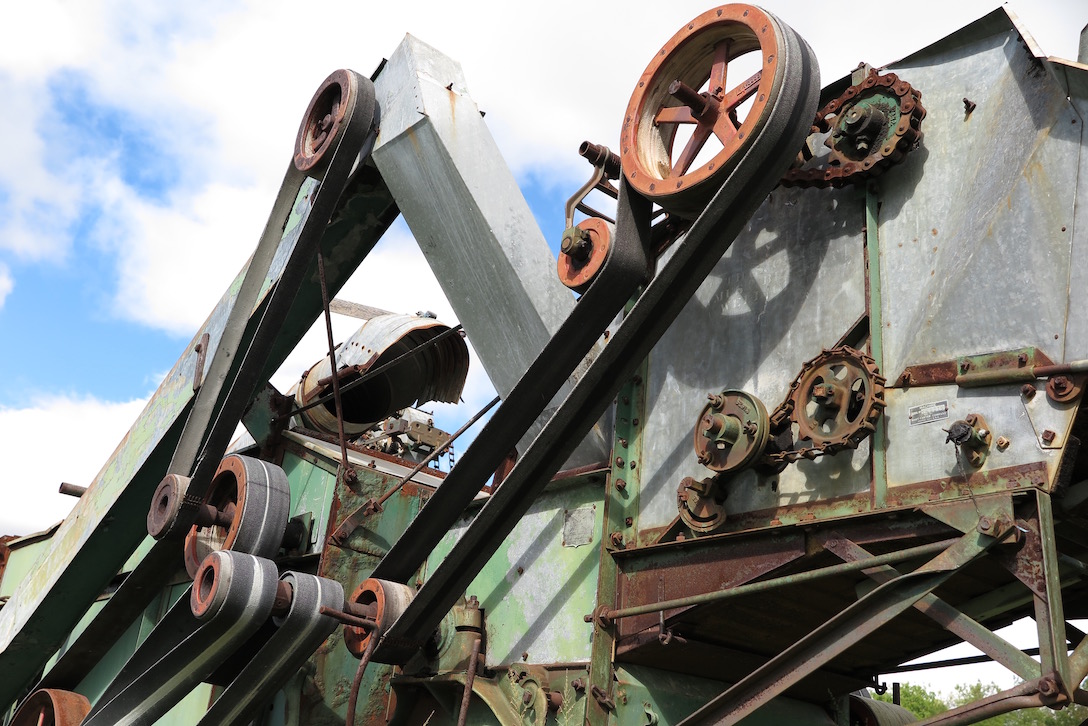
Rotating machinery with belts and chains
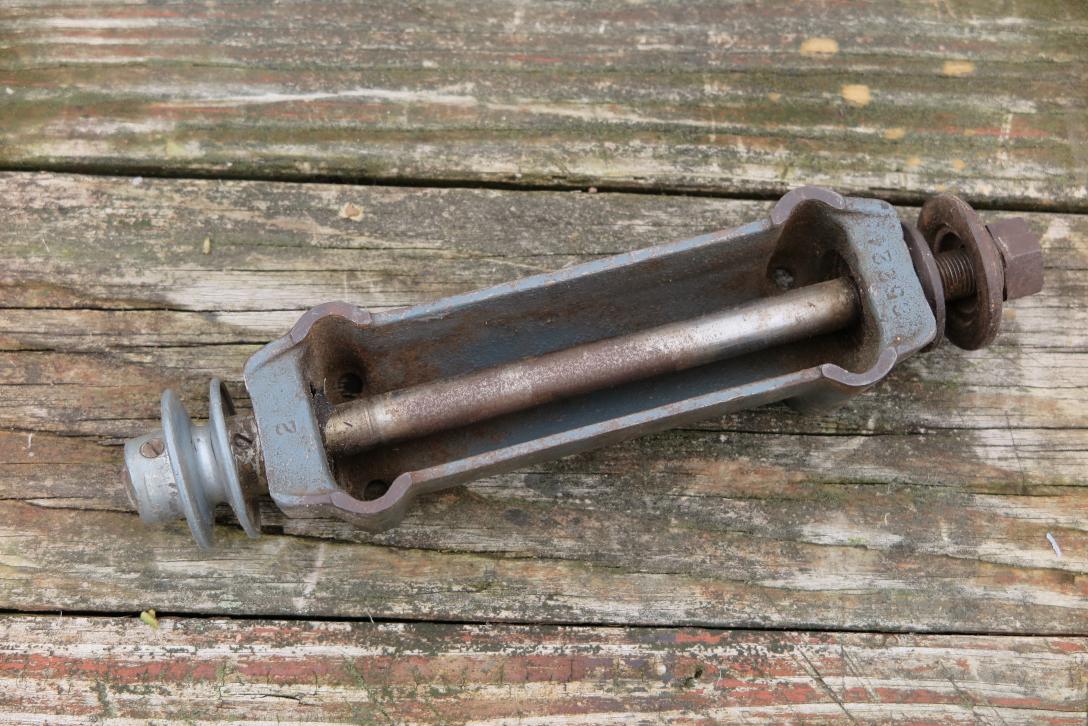
Shaft with bearings and pulley end
A transmission is a mechanical system that transmits physical power from one component to another, frequently with a change in characteristics. A familiar example is an automotive transmission that transfers power from the engine to the wheels while simultaneously converting it from a high-speed, low-torque form to low-speed, high-torque form. Other examples of rotary transmissions include bicycle chain and sprocket systems, and automotive "fan" belts (generally multi-component serpentine belts these days).
A transmission need not be a rotary system, though many
involve rotational components.
A rack-and-pinion converts rotational motion to linear motion.
A crankshaft converts linear oscillation into rotary motion or vice versa.
Clever cam and lever systems can, in fact, be designed to convert
between nearly arbitrary movements.
The simplest transmission is a shaft, which is just an elongated component that transfers rotation (or occasionally linear motion) directly from one end to the other. A shaft can be short or long. It is usually supported by bearings at both ends, and sometimes at intermediate locations as well. Shafts are most commonly hollow cylinders, which both provide good torsional strength for a given weight, and are relatively easy to produce. Small shafts are sometimes solid, mostly for convenience of manufacture. Shafts of square cross section are sometimes seen in low-precision machinery to facilitate connection to other rotating components. Splined ends or cross sections facilitate connections to other components in higher precision applications.
A slight bend can be introduced between shafts connected end-to-end by use of a universal joint or a constant-velocity (CV) joint. A universal joint consists of a cross-shaped pivot element inserted between interlocked, forked ends of the coupled shafts. This relatively simple mechanism has been known for several centuries; it has the disadvantage that it introduces a slight variation between the angular velocities of the coupled shafts. This can cause vibration, particularly in rapidly rotating or heavily loaded machinery. A pair of universal joints phased at 90 degrees to each other and at equal angles to an intermediate shaft will produce constant velocity transmission, but the arrangement is not compact, and the intermediate shaft needs support. A number of more complex constant-velocity mechanisms were developed in the 20th century that reduce or eliminate the problem.
Rotational transmissions are frequently composed of an arrangement
of parallel shafts, each of which is connected to its neighbors via
one of a few basic pairwise linkages.
These include belt/pulley, chain/sprocket, roller, and simple gear linkages.
More complex linkages include
planetary or epicyclic gear systems and
harmonic drives.
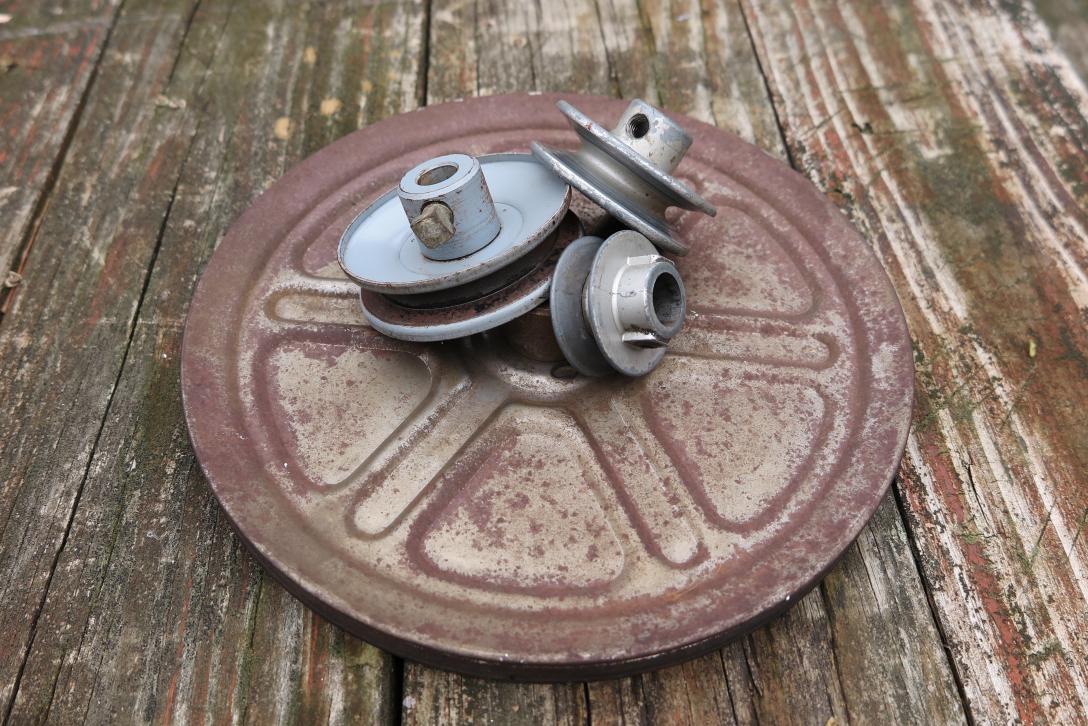
Miscellaneous pulleys
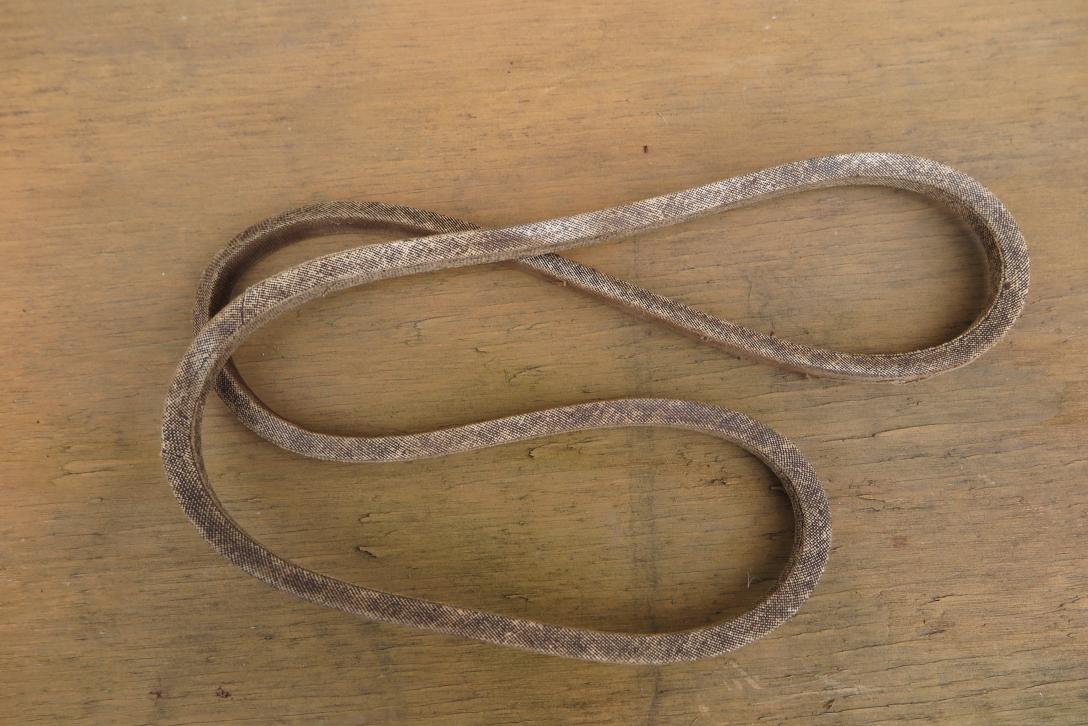
A typical V-belt
One of the oldest transmission linkages is the belt/pulley system. This consists essentially of a pair of wheels rotating in the same plane (the pulleys) and connected by a closed loop of flexible material (the belt). The rims of the pulleys are typically grooved or otherwise shaped to retain the belt, which is kept under tension so that as one wheel turns, the belt turns the other at the same tangential velocity.
In the most basic variety, the load is transfered solely by friction between the belt and the pulleys. Such an arrangement can slip, which may be desireable if the alternative is breakage or jamming. Systems employing toothed belts and ridged pulleys (sprockets) are used in situations where slip can not be tolerated (e.g. an engine timing belt).
Since a belt preserves tangential velocity between the pulleys, rotational speed can be increased or decreased between shafts by using pulleys of different diameters. In the absence of slip, the ratio of rotational velocities is equal to the inverse ratio of diameters (rpm2/rpm1 = d1/d2).
There are two classic approaches to keeping belts on the pulleys. The first, used most often with thin belts or cords, is to have the belt run in a groove in the pulley. The groove must be fairly steep and deep, or have slippery sides, or the belt will tend to climb out of it. So-called "V-belt" pulley systems are of this sort.
The second approach, called crowning, is used most often with wider, flat belts. Here, the circular surface of the pulley, on which the belt rides, is raised or "crowned", towards the center, making it slightly convex. Contrary to what might be expected intuitively, this arrangement causes the belt to dynamically center itself when the system runs. It is the same dynamic effect that causes a belt to climb out of a groove if the edges are not steep or slick enough.
A third, more modern approach, is to employ specially formed belts with several parallel, longitudinal ridges or grooves on the inner surface, which run in corresponding grooves or ridges cut in the pulley. Serpentine belts on modern automobiles are usually of this form.
Modern belts are typically complex composites of tensile fibers bound with rubbery elastomers. Fibers range from linen, to glass, to polyester and kevlar, to high-tensile steel wire. This last can match chains for strength for a given cross-sectional area, if not for slip-proofness.
When the industrial revolution made it possible to mass produce identical components inexpensively, belts were replaced in some applications with special metal chains that turned toothed sprockets. Chains could transmit higher forces than the belts of the day. They have the additional attribute that slippage can be entirely prevented, so they can be used to implement synchronized mechanisms. The idea of power-transmitting chains is actually fairly old, and is seen in some ancient Greek design documents, though it is unknown if the mechanisms were actually constructed.
A common design, exemplified by your everyday bicycle chain, is technically known as a roller chain. It comprises a double chain of small figure-8 plates, joined by pins, and separated by bushings on which ride small "roller" elements that fit into semi-circular cuts in the sprocket gear. The design requires lots of identical small parts, and was impractical to make before industrial mass production, but relatively easy once that capability existed. Because of this, such chains were not actually employed in machinery before the late 1800s; however drawings by Leonardo da Vinci from the early 1500s portray a nearly identical mechanism.
The familiar "caterpillar tread" seen on bulldozers and tanks can be considered a form of chain drive. In this case, the chain transfers power not between a pair of sprockets, but between a sprocket and the ground.
Compared to belts, chains run without slipping, and are more robust in that sense than even toothed belts, which can slip if they lose tension momentarily. Chains do not have to be kept under significant tension, and can even be run loose in some applications. They are stronger, and can transmit more force than than all except specially engineered belts. If well lubricated and maintained, they have very long lifetimes. On the down side, they are heavier and significantly more expensive than belts. Unless exceptionally well engineered, they do not run as quietly or as smoothly. They can also introduce vibration between the rotations of connected shafts due to a slight variation in contact radius as the sprocket teeth pick up the chain links.
If two cylinders with parallel axes are pressed together, the friction between the faces will cause them to rotate together at angular velocities corresponding to the ratio of their diameters. Cylinders so interfaced are called rollers, and can be used to transmit mechanical power.
Rollers are relatively simple to manufacture, and can produce arbitrary rotation ratios. The tricky part is maintaining sufficient pressure between rollers so that they do not slip excessively. Coefficients of friction tend to max out around unity, and often are considerably smaller. This tends to limit the forces (and power) that can be transmitted. For this reason, rollers are most often used in applications where forces are low, and slip can be tolerated, as in tape drives or feed systems for other flexible materials. They are often made using soft materials (e.g. rubber) so that the pressure does not change dramatically due to small dimensional variations.
There are high-tech systems, notably some
continuously variable transmissions,
that use rollers to transmit large amounts of power.
These transmissions contain special mechanisms that maintain
large normal forces (e.g. thousands of pounds) between rollers.
Bearings in such systems must be specially designed to take the high,
continuous loads. Slip must be avoided, as under high-pressure,
high-friction conditions it can cause near-instantaneous damage
to in-contact surfaces (the dissipated energy has to go somewhere).
Special lubricants and materials can help ameliorate the problem.
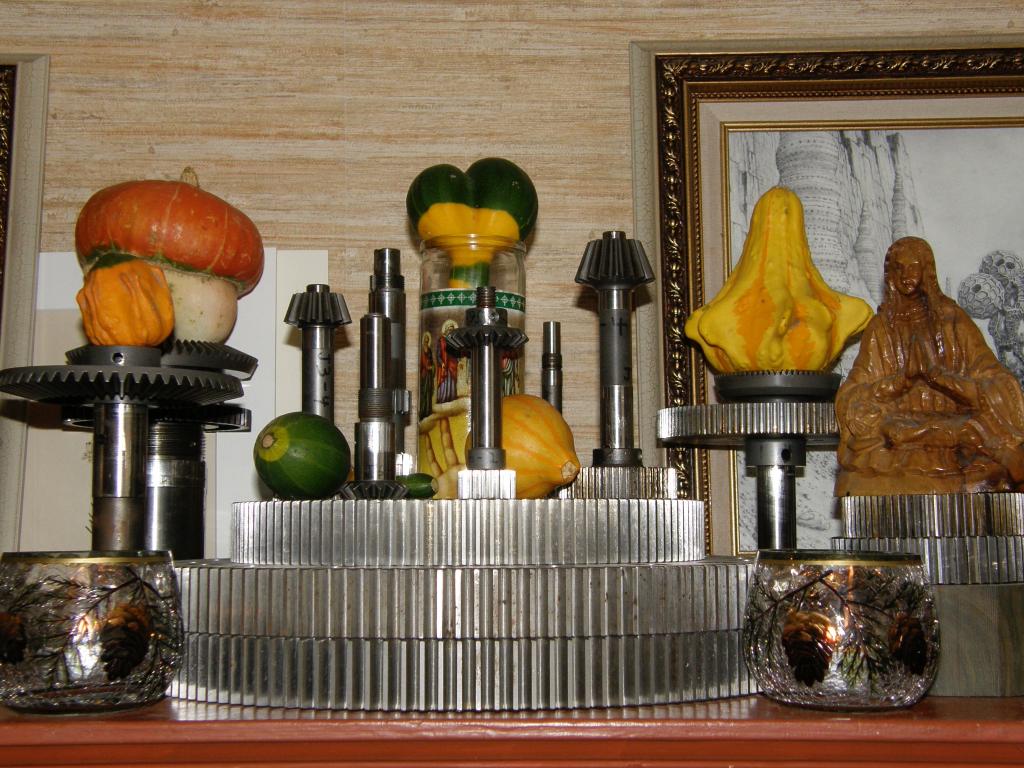
Our Lady of the Gears
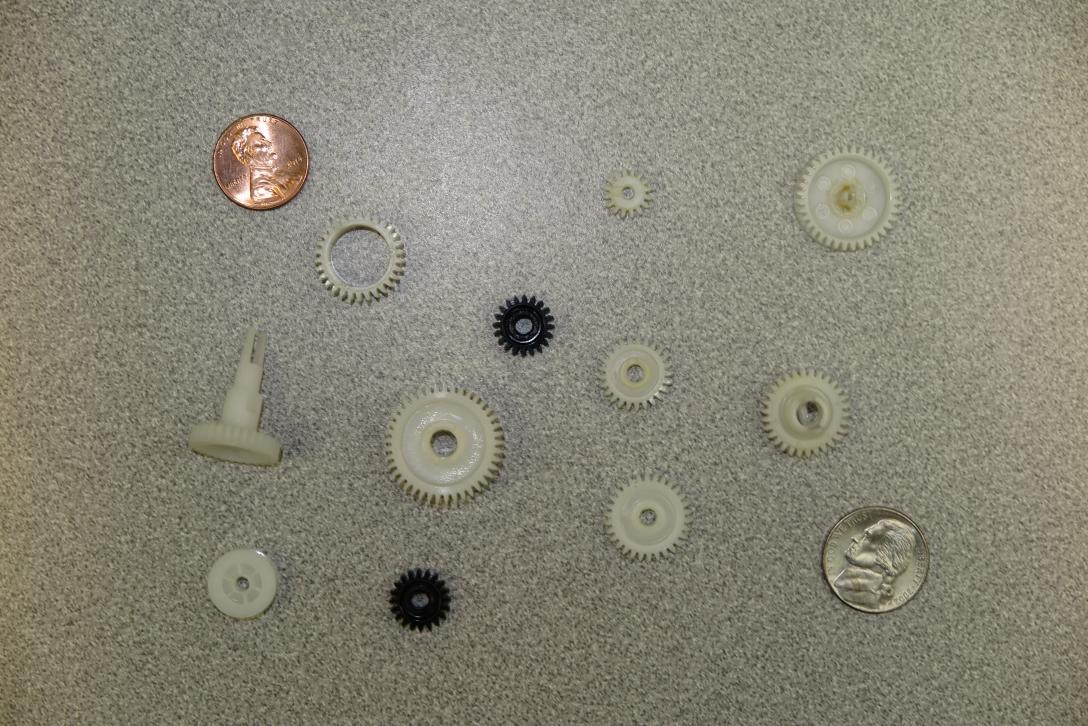
Small plastic gears
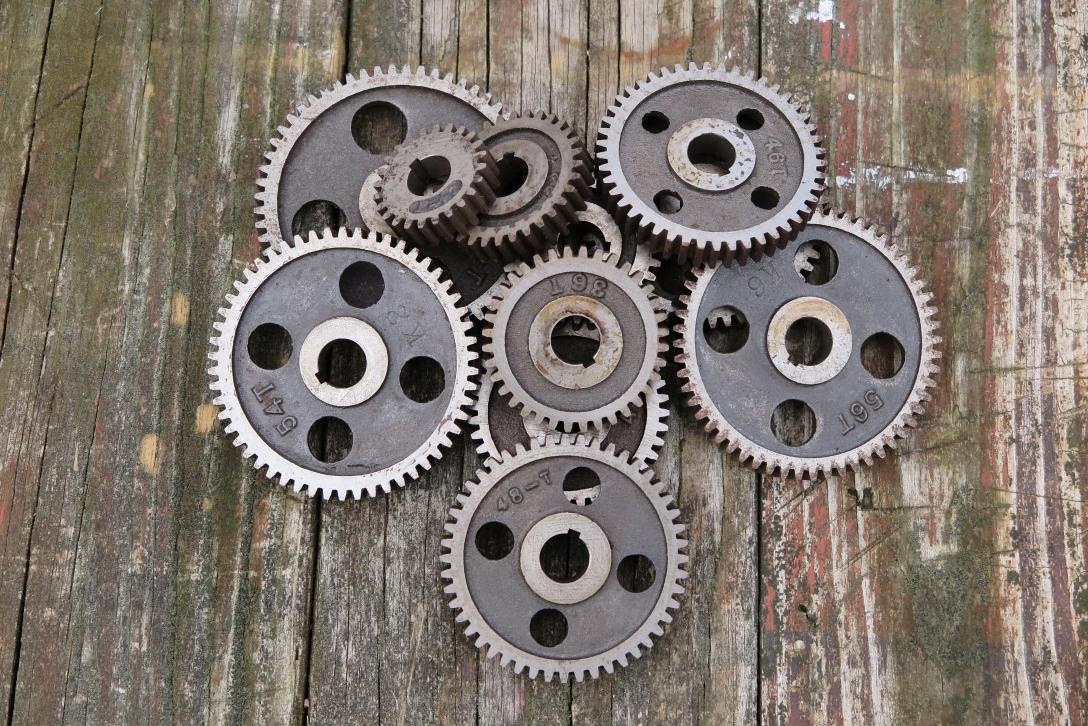
Metal spur gears
Ordinarily, when we think "mechanical transmission" we think gears. There is good reason for this. Properly made gears are strong, compact, and run smoothly, and quietly. They can transmit large amounts of power and run at very high speeds. The main downside is that to obtain these benefits, precise engineering is required. Spacing in high-speed power systems must generally be corrrect within a few thousandths of an inch, and the gears themselves must be precise within a few ten thousandths, with well-finished mating surfaces. This tends to increase costs. Gear systems usually must be partially or totally enclosed to retain lubrication and prevent contaminants from damaging the precision surfaces.
Gears are more complicated than you probably think they are. They are not just wheels with prongs that push each other around, but pieces of high-precision engineering with teeth that must match mathematically-defined curves within a few ten-thousandths of an inch. Or your machine will self-destruct from vibration.
Up until the middle of the 17th century, gears were just wheels with prongs that pushed each other around. They were used in mills and clocks and other low-speed applications, but attempts to use them in high-speed mechanisms produced destructive vibrations. Engineers realized that to run without vibration, the teeth of gears needed to be specially shaped so that as they slid past each other under load, a constant angular velocity in the driving gear produced a constant angular velocity in its driven partner. Triangular or trapezoidal teeth do not satisfy this condition.
It was known empirically that better results were obtained with slightly convex teeth, and that over time, gear teeth tended to wear into shapes that ran smoothly. This fact was utilized to produce matched gear sets by running roughly-shaped gears against each other in an abrasive environment, a procedure known as lapping that is still used in final fitting of high-quality gear trains. However, a precise description of the required shape was not obvious.
Sometime in mid-1600s, it was realized that a curve known as the cycloid, could be used to produce constant-velocity gear teeth. A cycloid is the curve produced by a point on a circle as the circle rolls along a line. The actual discoverer does not appear to be known. Cycloidal teeth were time-consuming to make, so such gears were expensive, and used only in critical applications.
In the mid-1700s, the great French mathematician Leonhard Euler proved that a curve known as the involute, could also be used to make constant-velocity gearing. An involute is the curve developed by the end of a string kept tight as it unrolls from a stationary circle.
It turns out that over a broad range of conditions, given an arbitrary tooth shape, it is possible to to develop a conjugate curve for a mating gear that produces a constant-velocity drive. However, the cycolid and the involute are unusual in that they are self-conjugate closed mathematical forms. For the involute, there is a relatively simple, geometrically derived procedure that can be used to cut gear teeth. Involute gears can thus be made relatively cheaply. Involute gears also have the property that the distance between gear centers can be varied slightly without affecting the constant velocity characteristics. Cycloidal gears must be exactly spaced. For these reasons, almost all modern gears are made with involute teeth.
Article on cycloidal gears from Elizabeth R. Tuttle and J. B. Calvert
There exist a large variety of gears forms. The simple, flat gears with teeth around the edge of a disk or cylinder, are known technically as spur gears. Gears with teeth cut on the angle of a cone section rather than the edge of a disk, so they transmit motion between non-parallel shafts are bevel gears. Gears with teeth on the outside of a cylinder or cone are called external gears. Those with teeth on the inside are internal gears
Gears intended for the transmission of large amounts of power at high speeds often have teeth whose profile is aligned with a spiral around the shaft rather than parallel to it. These are called helical gears and they run more smoothly and with less noise than simple spur gears. Bevel gears can be spirally cut to achieve the same advantages. Helical gears produce thrust on the shafts, so appropriate bearings must be employed. Thrust can be avoided, at additional complexity and expense, by using doubled gears with helices of opposite handedness. If combined into a single disk, the result is called a herringbone gear
Helical gears can be cut so they operate between crossed shafts This is accompanied by some sliding action along the teeth. Such arrangements are sometimes called skew gears. Taking this idea to an extreme, where one helix is screw-like, and the other nearly parallel to the rotation axis produces a worm gear Worm gears produce very high reductions in rotation, and may or may not be back-drivable (able to be pushed in reverse) depending on the angle of the screw-like helix.
A gear system where one of the elements is a toothed bar, is known as a rack and pinion. The linear element is the rack, the circular gear the pinion. The arrangment is useful for producing smooth linear motion.
Gears are specified by their pitch and their pressure angle. Pitch specifies the distance between teeth on the pitch circle, which can be thought of as defining a roller that would act in the same way as the gear. The pitch circle is usually about halfway through the teeth. Two perfectly mating gears would have their centers separated by the sum of their pitch radii.
The pressure angle measures the effective tilt of the teeth. Technically, when gear teeth are in contact, it is the angle between the normal to the tooth face and the surface of the cylinder (roller) defined by the pitch circle. It is also the angle of the trapezoidal teeth that make up the corresponding rack. If sliding friction is ignored, forces are perpendicular to the contacting surfaces. A non-zero pressure angle thus produces a force pushing the gears apart which must be taken up by the bearings. This force is proportional to the tangent of the pressure angle times the tangential (mechanically effective rotational) force the gears exert on each other.
For gears to mesh correctly, they must have the same pitch and pressure angle. To faciliate this, gears are mass-produced to standard values. They need be consistent in other respects as well, such as helix angle, tooth depth and tooth width but pitch and pressure angle are primary specifiers.
Pressure angle is usually specified in degrees both for inch and metric gears. Standard values are 14.5, 20, and 25 degrees. Larger pressure angles increase the strength of the gears, but produce larger separation forces, increasing the load on the bearings.
Pitch in the English (inch) system is usually given as diametral pitch which specifies number of teeth on a one-inch diameter gear. Standard diametral pitches are 3, 4, 5, 6, 8, 10, 12, 16, 20, 24, 32, 48, 64, 72, 80, 96, 100, 120 and 200. The reason for this peculiar system is that if the pitch were specified in even inch fractions, then the diameters would have irrational values involving factors of pi. This would complicate design and manufacture. The pitch of metric gears is usually specified in terms of module which gives mm of gear diameter for each tooth. Gears intended to mesh with linear rack sometimes have pitch specified directly in fractional inches or mm.
The best way for the amateur robot constructor to use gears is in the form of commercial pre-built transmission units. Many small motors are available with attached gearboxes, and separate gear-down units with standard input and output shafts can be obtained.
Designing and building your own transmission is not a trivial matter. Matching the specifications of mating gears is only one, relatively simple consideration. In addition, each gear and its teeth must be appropriately sized to take the forces at that specific stage of the transmission. The same goes for shafts the gears are mounted on and their bearings. Spacing between gears needs to be highly accurate so that the gears neither bind, nor have excessive backlash. Allowable tolerance is generally on the order of a few thousandths of an inch of better.
There are other issues as well. Devising a compact layout for a multi-shaft transmission can require a considerable degree of cleverness and skill in arranging moving parts in three dimensions. To avoid problems with periodic wear patterns, designers often try to ensure that the number of teeth on mating pairs of gears are relatively prime, which imposes additional constraints. At high speeds, unexpected vibrations associated with mechanical resonances can appear. If not controlled, extremely rapid wear can result. Appropriate lubrication must be assured for all gears and bearings. This generally means the construction of a closed or semi-closed housing to retain lubricant and prevent contamination by abrasive dirt and other foreign bodies. Human or animal hair is a particularly diabolical contaminant, especially in low-power transmissions, winding around and impeding shafts and their bearings.
In summary, geared transmission design is not a job for the faint-of-heart. A possible exception exists for a single stage of gearing at the low-speed end of a mechanism. In this case, it may be possible to mount gears on existing shafts, employing their bearing systems. A bit of grease or oil can suffice for lubrication if the speed is not high enough to fling it off. Correct spacing is still important, but not as much as when multiple high-speed shafts are involved. Rack-and pinion steering is an example of such a terminal, low-speed application.
A helical joint is basically a screw. It has one degree of freedom, but that freedom couples rotational with linear movement. Mechanically, a helix can be considered as a continuous inclined plane. Helical drives are widely used to convert rotational movement to linear translation. They are generally implemented using a helical shaft (a screw) that fits into a matching (tapped) hole. Steep helices may be double, triple, or higher, with several parallel threads wrapping around the shaft. For simple, single helices, the linear movement produced by a 360 degree rotation of the shaft is often relatively small compared to the diameter of the shaft. This leverage allows helical linkages to produce large force amplification. They can also provide an exceptional degree of precision, repeatability, and rigidity.
High leverage (shallow) helices produce correspondingly slow linear movement.
Linkages with steep helices can produce fairly rapid linear motion.
If the helix is steep enough, the joint may be
back-drivable,
permitting linear action to be converted into rotation.
Most helical drives however, are not back-drivable.
This property can be deliberately exploited to produce powered
mechanisms with self-locking characteristics.